The new Minolta DiMAGE A1 features the same 5.3 megapixel CCD image sensor and 7x optical zoom lens as its predecessor, but has improvements in a number of areas. Changes include 14-bit A/D conversion, a tilting LCD monitor, larger and slightly higher resolution electronic viewfinder, 1/16,000 second (!) maximum shutter speed, tracking autofocus, a new anti-shake mode that actually moves the image sensor horizontally and vertically to minimize camera shake, remote control via USB, a new Lithium-Ion battery cell and a grip sensor that actually senses when you have the camera in-hand, to save power in the continuous autofocus mode. There's also a new optional accessory grip available which adds a vertical grip handy for portrait-format shots, and allows the camera to be powered by either two NP-400 batteries, or by conventional rechargeable AA cells.
Courtesy of Minolta, full specifications follow and a "backgrounder" on the DiMAGE A1 follow. Pricing and availability have not yet been announced.
Our apologies to readers who've been waiting patiently for the last few hours for our coverage of this announcement. We were told not once, but twice that this announcement was scheduled for 12PM Eastern Standard Time today - yet all four of today's announcements appeared more than 12 hours early on digitalkamera.de, and even Minolta Japan's own site had them up far in advance of the supposed "worldwide" announcement time we were given. To make matters worse, believe it or not the DiMAGE A1 was actually being shown in public at a trade show in New Zealand two days ago!
We're only just completing work on the news items as they are now posted - hours in advance of what we'd been led to believe would be the correct time. It is disappointing to be scooped in this manner - we always try to be the first to bring you the news, often posting the very second an NDA expires. You'd think it would be a simple matter for multinational companies to synchronise their announcements worldwide; apparently not.
| Minolta DiMAGE A1 |
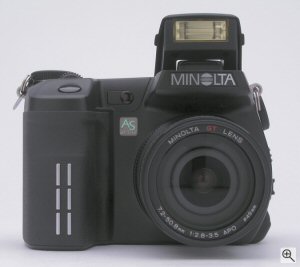 |
| Number of effective pixels | 5.0 million |
| CCD | | 2/3-type progressive primary-color CCD | | Total pixels: 5.3 million | |
| A/D conversion | 14 bit |
| Camera sensitivity | Auto, ISO 100, 200, 400, 800 equivalents |
| Focal length | 7.2 – 50.8mm (35 mm equivalent: 28 - 200 mm) |
| Lens construction | 16 elements in 13 groups (includes two AD glass elements and two aspheric elements) |
| Maximum aperture | f/2.8 – f/3.5 |
| Minimum focus distance | 1.6 ft. (0.5m) from CCD |
| Macro focus range | | At 7.2mm: | | 11.8 – 23.6 in. (30 – 60 cm) from CCD | | 8.3 – 20 in. (21 – 51 cm) from front of lens | | At 42.7 – 50.8mm: | | 9.8 – 23.6 in. (25 – 60 cm) from CCD | | 5.1 – 19.7 in. (13 – 50 cm) from front of lens | |
| Maximum magnification | | 0.177x (1: 5.65) | | Equivalent to 0.7x (1: 1.43) in 35mm format | |
| Area covered at maximum magnification | 1.97 x 1.46 in. (50 x 37 mm) |
| Optical zooming control | Manual zooming ring |
| Filter diameter | 49mm |
| Viewfinder type | | EVF (Electronic viewfinder) | | Variable-position: 0-90º | |
| Viewfinder LCD | | 0.44 inch (11mm) TFT liquid-crystal microdisplay | | Total pixels: 235,000 pixels | |
| LCD monitor | | 1.8 inch (46mm) low-temperature polysilicon TFT color | | Variable-position: -20- 90º | | Total pixels: 118,000 | |
| Automatic monitor amplification | Activates in low light. |
| Field of view | | EVF: Approximately 100% | | External LCD monitor: Approximately 100% | |
| Display-mode switch | Auto-display, Electronic-viewfinder display, External LCD-monitor display |
| Diopter control | – 5 ~ +2 m-1 |
| Eye relief | 22mm at -1 m-1 |
| Shutter | CCD electronic shutter and mechanical shutter |
| Shutter speed range | | 30 - 1/16,000 second | | Bulb (maximum 30 seconds) | |
| Autofocus system | Video AF |
| Autofocus areas | | Wide focus area, Spot focus point | | Flex Focus Point control is available with the spot focus point. | |
| Focus modes | | Autofocus: Single-shot AF, Continuous AF, Full-time AF, Subject | | Tracking AF. | | Manual focus with 2x or 8x Flex Digital Magnifier (FDM) | |
| Full-time AF | | With the spot focus point or Flex Focus Point. | | Full-time AF can be disabled. | |
| Subject Tracking AF | With continuous AF. Subject Tracking AF can be disabled. |
| Focus lock | By pressing shutter-release button partway down. |
| Subject lock | With Subject Tracking AF by pressing shutter-release button partway down. |
| Metering | Multi-segment, Center-weighted, Spot (center or with Flex Focus Point) |
| Multi-segment metering | 300 segments |
| Exposure control range | | Programmed AE and aperture-priority modes: | | Wide: EV –1 – 20 | | Telephoto: EV –0.4 – 20.7 | | Shutter-priority and manual modes: | | Wide: EV – 2 – 21 | | Telephoto: EV – 1.4 – 21 | |
| Exposure modes | Programmed AE (with program shift), Aperture priority, Shutter priority, Manual |
| Digital Subject Programs | Portrait, Sports action, Sunset, Night portrait |
| Exposure compensation | ± 2 EV in 1/3 increments |
| AE lock | With AE-lock button or by pressing the shutter-release button partway down |
| Flash control | ADI, Pre-flash TTL, Manual flash control |
| Flash range | | Wide: Approximately 1.6 – 12.5 ft. (0.5 - 3.8m) | | Telephoto: Approximately 1.6 – 9.8 ft. (0.5 - 3m) | | (Camera sensitivity: auto) | |
| Flash modes | Fill-flash, Red-eye reduction, Rear flash sync, Wireless/Remote flash |
| Flash recycling time | Approximately 5 seconds |
| Flash compensation | ± 2 EV in 1/3 increments |
| Flash-sync speed | All shutter speeds |
| External flashes | | Auto-flash metering with Program/Maxxum Flash 2500 (D), 3600HS (D), 5600HS (D), Macro Twin Flash 2400,* Macro Ring Flash 1200.* | | *Macro Flash Controller is necessary. | | Non-dedicated off-camera flash units can be used using the camera’s flash-sync terminal. | |
| Continuous advance | | - High-speed continuous advance: Maximum 2.8 frames per second | | - Standard continuous advance: Maximum 2 frames per second | | *Actual speed may vary depending upon the subject and camera settings. | | Approximate number of frames that can be captured at one time:����������������� | | � | 2560 x 1920 | 2080 x 1560 | 1600 x 1200 | 640 x 480 | | RAW | 5 frames | - | - | - | | TIFF | 3 frames | 3 frames | 3 frames | 3 frames | | Extra Fine | 3 frames | 3 frames | 3 frames | 3 frames | | Fine | 3 frames | 3 frames | 3 frames | 3 frames | | Standard | 3 frames | 3 frames | 3 frames | 3 frames | | *Actual number of images may vary depending upon the subject and camera settings. | |
| Interval recording | | 2 – 240 frames | | Interval time: 30 seconds, 1 – 10 minutes, 15 minutes, 20 minutes, 30 minutes, 45 minutes, 60 minutes | | Start time: 0-24 hour in 0.5 hour increments. | |
| Exposure bracketing | Three-frame bracket in 0.5 and 0.3 EV increments |
| Digital Enhanced Bracketing | Three-frame contrast, color saturation, or filter bracket in fixed increments. |
| Self-timer | Approximately 10 seconds, 2 seconds |
| Movie | | - Standard movie mode: Maximum 15 minutes at 24 frames per second with monaural audio | | - Night movie mode: Maximum 15 minutes at 24 frames per second with monaural audio | | - Automatic selection function between standard and night movie modes available. | | - Time-lapse movie mode: no audio and played back at 4 frames per second | |
| Audio | Voice memo: Maximum 15 seconds monaural audio with still image |
| Color modes | Natural Color (sRGB), Vivid Color (sRGB), Adobe RGB, Embedded Adobe RGB, Black and white (neutral and toned), Solarization |
| Camera color spaces | sRGB, Adobe RGB |
| White-balance control | | Automatic | | Preset (Daylight, Tungsten, Shade, Cloudy, Flash, and Fluorescent settings) with fine adjustments in seven levels. | | Custom (three settings) | |
| Sharpness settings | Three levels (Soft, Normal, Hard) |
| Digital Effects Control | Color saturation, Contrast compensation, Filter |
| Noise reduction | User selectable dark noise reduction |
| Digital zoom | 2x with still images |
| Data imprinting | | Year/month/day (Format can be changed.) | | Month/day/hour:minute | | Text | | Text and serial numbers | | Imprinting can be disabled. | |
| Custom functions | | Control dial customization. | | User-selectable function can be assigned to the function dial. | |
| Image-quality modes | RAW, TIFF, Extra fine, Fine, Standard |
| Size of recorded still images | 2560 x 1920, 2080 x 1560, 1600 x 1200, 640 x 480 |
| Size of recorded movie clips | | 320 x 240 in standard and night movie modes | | 640 x 480 in time-lapse movie mode | |
| Storage capacity | | Approximate storage capacity of a 16 MB CompactFlash card: | | � | 2560 x 1920 | 2080 x 1560 | 1600 x 1200 | 640 x 480 | | RAW | 2 frames | - | - | - | | TIFF | 1 frames | 1 frames | 2 frames | 15 frames | | Extra Fine | 2 frames | 4 frames | 7 frames | 35 frames | | Fine | 5 frames | 8 frames | 14 frames | 47 frames | | Standard | 10 frames | 14 frames | 23 frames | 63 frames | | Movie | 19 seconds with 320 x 240 images | | * Still images recorded without voice memo. | | ** Actual number of images may vary depending upon the subject and memory card used. | |
| File formats | | JPEG, TIFF, Motion JPEG (MOV), RAW, WAVE | | DCF 1.0-compliant | | DPOF-compliant (Supported by printing functions in version 1.1) | | Exif 2.2 | |
| Printing output control | Exif Print, PRINT Image Matching II |
| Recording media | | Type I and Type II CompactFlash cards | | IBM Microdrive (170MB, 340MB, 512MB, 1GB) | |
| Computer interface | Full-speed 12Mbps USB |
| AV output | NTSC, PAL (selected on the camera) |
| Batteries | One NP-400 lithium-ion battery |
| Battery performance (Playback) | Approximate continuous playback time: 300 minutes with NP-400 lithium-ion battery, External LCD monitor on, EVF off. |
| Battery performance (Recording) | Approximate number of recorded images: 330 frames with NP-400 lithium-ion battery, EVF on, External LCD monitor off, Full-size images (2560 x 1920), Fine image quality, No instant playback, No voice memo, Flash used with 50% of the frames. |
| External power source | 6V DC with specified AC adapter (sold separately) |
| Dimensions (WxHxD) | 4.61 x 3.35 x 4.47 inches (117 x 85 x 113.5mm) |
| Weight | Approximately 19.8 oz. (560 g) without batteries or recording media |
| Operating temperature | 32-104 ºF (0-40 ºC) |
| Standard accessories | Neck Strap NS-DG4000, Lens Cap (49mm) LF-1249, Accessory Shoe Cap SC-10, AV Cable AVC-400, 16MB CompactFlash Card, USB Cable USB-500, DiMAGE Viewer, Lens Shade DLS-1, Lithium-ion Battery NP-400, Lithium-ion Battery Charger BC-400 |
| Optional accessories | AC Adapter AC-1L, Leather Neck Strap NS-DG1000, Holding Strap HS-2, External High Power Battery Pack Kit EBP-100, Remote Cord RC-1000S, Remote Cord RC-1000L, Step Up Adapter 49mm – 62mm, CompactFlash Adapter for SD Memory Cards SD-CF1, Battery Pack BP-400, DiMAGE Capture |
| More Photos |
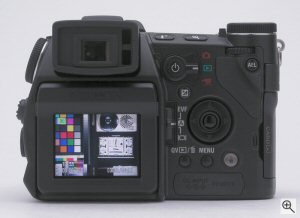 |
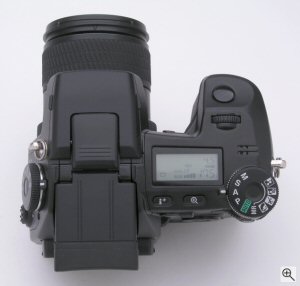 |
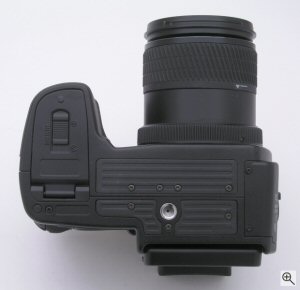 |
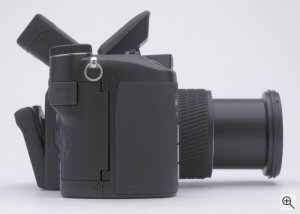 |
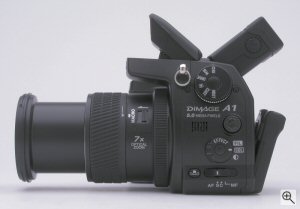 |
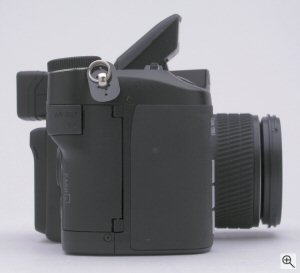 |
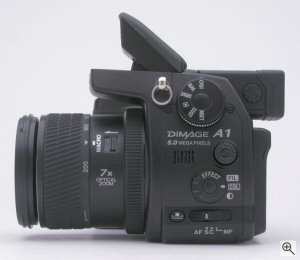 |
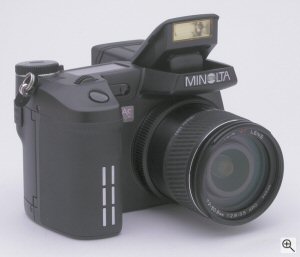 |
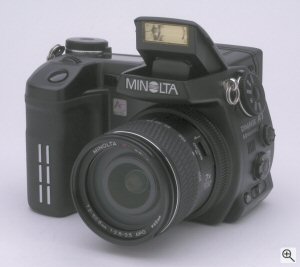 |
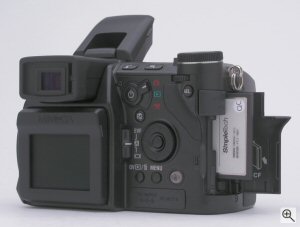 |
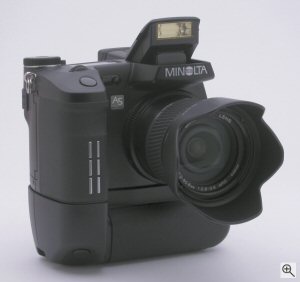 |
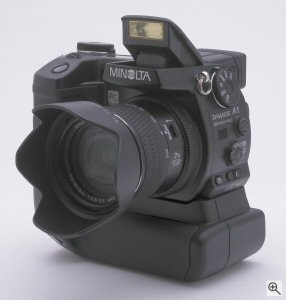 |
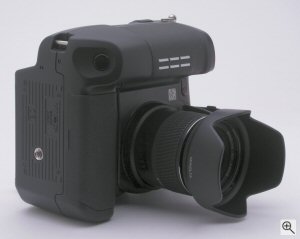 |
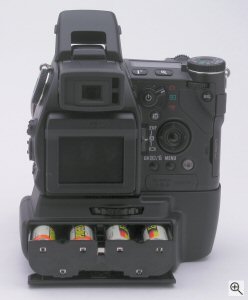 |
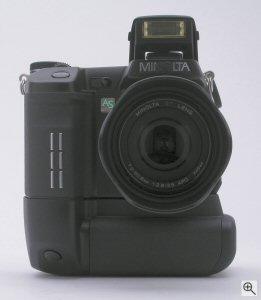 |
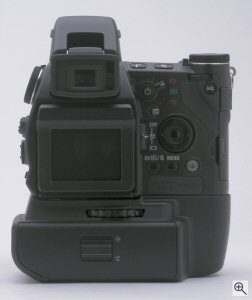 |
| . |
New Minolta Single Lens Reflex (SLR)-type Digital Camera: The DiMAGE A1
Minolta’s new DiMAGE A1 5-megapixel digital camera builds on the success of Minolta’s highly acclaimed DiMAGE 7 series of digital cameras.� This next generation SLR-type digital camera includes these key features:
- World’s Fastest Autofocus Speed*
- Shutter speed of 1/16,000 of a second
- Dual-focal macro system
- New image quality and image-size settings
- 3-D Predictive Focus Control and Subject Tracking
- Anti-Shake function
- Minolta’s new CxProcess II
- Compatibility with accessory and studio flash systems
Main Features:
World’s Fastest Autofocus (AF) Speed*
The new Minolta DiMAGE A1 features the world’s fastest AF speed among 5-megapixel SLR-type digital cameras with a non-interchangeable 5x or greater optical zoom.* Full-time AF continually focuses when the grip sensor is activated to reduce focusing time as well as to continually display a sharp image on the monitors.
Fast Shutter Speed
The DiMAGE A1 has an incredible top shutter speed of 1/16,000 of a second. This is not only an advantage in sport photography, but also gives greater control over depth of field in brightly-lit scenes by allowing the entire aperture range to be used. In low-light conditions, shutter speeds up to 30 seconds can be selected as well as thirty-second bulb exposures.
High-Precision Electro-Optical System
The DiMAGE A1 is built around a high-precision electro-optical system designed to maximize image quality. The system starts with a 5.3 megapixel 2/3-type progressive primary-color CCD with 5.0 million effective pixels for fine high-resolution images. The pixel resolution of the CCD will produce 13” x 17” 150dpi prints or 6.5” x 8.5” photo-quality prints; this creates a print size larger than both 11” x 17” and 5” x 8” respectively.
The DiMAGE A1 uses 14-bit A/D conversion to record the richness and infinite subtleties of light. 14-bit A/D conversion can distinguish 16,384 levels in each color channel. This is a fourfold increase over the fidelity of 12-bit systems. Images simply come alive.
7x Optical Zoom Lens
A high-resolution CCD is as only as good as the lens in front of it. The fast f2.8 – f3.5 7x optical zoom is an advanced apochromatic (APO) lens employing anomalous dispersion (AD) glass to minimize chromatic aberration at all focal lengths and produce sharp, contrasty images. With a focal range of 7.2mm to 50.8mm, it is equivalent to a 28mm to 200mm 35mm zoom lens. This lens encompasses the most used focal lengths in photography today. It can range from wide angle for landscapes and interiors to telephoto for portraits and details of distant landmarks. A straightforward manual zooming ring makes framing quick and easy. The lens aperture can be adjusted in 1/3 stops allowing fine control over exposure.
Dual-focal Macro System
The Minolta DiMAGE A1 zoom features a dual-focal macro system that allows the lens to be set at the wide-angle or telephoto position to take advantage of different focal lengths. At the wide-angle position, the larger field of view and depth of field create a strong perspective and a sense of space. The telephoto position isolates the subject and minimizes distortion with a narrow field of view and shallow depth of field.
High Quality Images
For photographers who demand high-quality images, new image-quality and image-size settings have been added to the Minolta DiMAGE A1. The extra-fine image-quality option joins the fine and standard settings to produce a high-quality JPEG file with little compression or loss of detail. The new 2080 x 1560 image size gives the photographer the ability to switch between 5 megapixel, 3 megapixel, and 2 megapixel images smoothly to match the final use of the image with the optimum resolution to maximize storage space on the memory card. A 640 x 480 (VGA) image size is also available for web images.
3-D Predictive Focus Control
All cameras suffer from a slight delay between pressing the shutter-release button and when the image is captured. And at long focal lengths, this slight delay can be significant when photographing fast moving subjects. With continuous AF, the Minolta DiMAGE A1 uses Minolta’s new 3-D Predictive Focus Control to track the subject from when the shutter-release button is pressed all the way down until the exposure is made ensuring optimum focus. This new predictive focus control continually follows the subject through three-dimensional space not only to give the sharpest images possible, but also to reduce focusing time to catch the perfect moment.
Subject Tracking
The camera’s Subject Tracking AF uses the 3-D Predictive Focus Control system to lock on to and track a subject as it moves through the frame. A photographer simply places the subject in the AF frame and presses the shutter-release button partway down to engage the subject lock. The camera will then track the subject regardless of the direction of motion of the subject or camera.
Versatile Autofocus System
The DiMAGE A1’s AF system works in low-light conditions, the fading light of twilight or dimly lit interiors, without the need of a special AF illuminator. The monitor and viewfinder images are automatically amplified in these conditions so the subject is always visible.
Flex Focus Point adds unlimited versatility to the camera’s AF system. When the camera is placed on a tripod or when the position of the focal plane is critical as with close-up photography, it can be very difficult to use most autofocus systems because the camera must be moved to focus and then repositioned to compose the image. Flex Focus Point is a single crosshair sensor that can be placed anywhere within the field of view. With the camera on a tripod, a photographer simply uses the four-way key of the controller to position the Flex Focus Point on the subject. The camera’s AF system will then use that point for each exposure. The spot metering area can also be switched between a center spot and the Flex Focus Point.
Direct Manual Focus
The Minolta DiMAGE A1 incorporates Direct Manual Focus (DMF) – a feature found in professional-level 35mm film cameras such as the award-winning Minolta Maxxum 7. After the AF system has focused and locked on the subject, the focus can be fine-tuned manually.
The new Flex Digital Magnifier (FDM) can enlarge a section of the live image by two or eight times so sharpness can be judged in manual focus or when using DMF. The FDM marquee can be moved to frame the section of the image to be enlarged. Once enlarged, the live image can be scrolled so the entire image area can be examined.
Anti-Shake Function
The camera’s new Anti-shake function minimizes the effect of camera shake, a slight blurring of the image when the camera is handheld, to provide the sharpest image possible. The Anti-shake system is valuable when shooting at long focal lengths or in low-light conditions without a tripod. This allows the camera to be handheld with exposures approximately eight times longer than usual. When using the camera at the telephoto setting, approximately 90% of the images recorded will be sharp with a shutter speed of 1/25 second. The Anti-shake button glows to indicate the function is active.
Minolta’s CXProcess II
Minolta’s new image-processing technology – CxProcess II – controls the essential image qualities of color, contrast, and sharpness while minimizing noise. Brilliant, saturated color remains vibrant without becoming unnatural or flat. Subtle contrast is rendered to retain the richness and depth of the subject while preserving details in the highlights and shadows. Sharpness is controlled by balancing resolution with acutance to show fine details while minimizing hard, unnatural edges. Dark noise can be reduced with exposures of one second or longer with the noise-reduction menu option.
Digital Hyper Viewfinder
The redesigned Digital Hyper Viewfinder gives the camera the same feel as a 35mm SLR camera. It can be tilted between 0° and 90° for comfortable shooting at low angles or in confined spaces. The viewfinder has a new precision 235,000-pixel TFT monitor. Because the viewfinder LCD is shielded, it makes the perfect tool when working under bright light.
Unique LCD Monitor
The DiMAGE A1 is fitted with a 1.8-inch low-temperature high-contrast color LCD monitor that can be tilted from –20° to +90°. The monitor has an extended color gamut, contrast, and dynamic range. The monitor has a wide-viewing angle so that the camera does not need to be held perpendicularly to clearly view the live image.
Digital Effects Control (DEC)
The Digital Effects Control (DEC) is an image-processing center built into the DiMAGE A1. Contrast, color, and saturation can be adjusted before the image is captured to maximize image data at the scene. Contrast expands or contracts the tonal range to match the subject contrast. Saturation accentuates or subdues colors. The Filter effect controls the overall color of the image. When taking color images, the filter can affect the mood of the picture by making it cooler or warmer in eleven levels. When used with black and white images, the filter creates a warm or cool toned image similar to sepia or gold toners with photographic prints as well as the unique tones of magenta and green. Ten tones are available.
To guaranty the correct level of adjustment is made with the DEC, a Digital Enhanced Bracket can be made, a series of images with a slight increase and decrease in the quality selected. A photographer simply selects the bracketing drive mode and the image quality to be bracketed. The camera will automatically make a three-image bracket of the selected quality.
Digital Subject Program Modes
The camera’s Digital Subject Program modes optimize exposure and image-processing controls for specific shooting conditions and subjects. Simply select the appropriate Digital Subject Program and the camera is ready to shoot. Four subject programs are available: - Portrait: optimized to reproduce warm, soft skin tones and a slight defocusing of the background.
- Sports action: to make clear, sharp images of fast moving subjects.
- Sunset: optimized to reproduce rich, warm sunsets.
- Night portrait: for deep, subtle night scenes. When used with the built-in flash, the subject and background exposures are balanced.
Color Modes
As well as Natural Color and black and white, the DiMAGE A1 has two color modes for creative control: Vivid color and Solarization. Vivid Color increases the saturation to produce vibrant color images. Solarization creates a partial reversal of image tones to produce unique imaging effects. Two Adobe RGB options are available for color management applications so that the image can be captured with or without the Adobe RGB profile embedded.
Movie Mode
The DiMAGE A1 will not only produce great still-images, but also makes digital movies. There are multiple creative movie formats from which to choose. Standard QVGA (320x240) color movies and monochrome night movies up to 15 minutes with audio can be made. The night-movie mode can make recordings under extreme low-light conditions. The interval function can produce a series of still images taken at regular intervals or it can combine the images into 640 x 480 time-lapse movie. The time-lapse movie plays the images back at 4 frames per second so that normally imperceptible motion springs to life: the blossoming of a flower or changing cloud formations.
Real-time Histogram
Unique to digital imaging, the DiMAGE A1’s real-time histogram shows the luminance distribution of the image before it is captured. Displayed with the live image, the histogram allows the subject brightness and contrast to be evaluated to optimize the camera’s exposure and contrast controls. The luminance distribution of recorded images can be checked with playback histogram.
Intuitive Controls
The controls and dials are laid out for clear, intuitive operation. Two control dials are located on the front and back of the grip for quick changes to camera settings. Placed on the back of the camera, the controller is a straightforward five-way array used to control many of the camera’s advanced features and menus. The controller has been designed with a separate four-way key and central enter button. Separate buttons have been added for exposure compensation and custom white-balance settings. And a new switch makes it easy to change between single-AF, continuous-AF, and manual focus modes.
Professional Style
The DiMAGE A1 is wrapped in a feather-light magnesium-alloy case with a professional black finish. The camera has been completely redesigned to reflect the utility and sophistication of digital technology. Significantly smaller than a compact 35mm SLR camera with a built-in flash and zoom lens, this sophisticated imaging system can easily slip into a fanny pack or shoulder bag. A new textured grip gives the DiMAGE A1 secure, comfortable handling.
Automatic Camera Sensitivity
Automatic camera sensitivity adjusts between ISO 100 and 200 equivalents as the lighting conditions change to maximize shutter speeds to reduce camera shake. Monitor amplification brightens the monitor image under low light so that composition can be checked. This function can be turned on or off, or set to automatically active in low light conditions.
Data Imprinting
Data imprinting allows the date or time to be printed on the image as well as text and serial numbers. A 16-character subject line describing the images can be added to the exif data and read with the DiMAGE Viewer. This subject line can be printed out with a copy of the image from the DiMAGE Viewer application. The electronic keyboard used to imprint text has an expanded character set for European languages. Diacritical marks are added to certain vowels and the German double “S” is available. System Accessories
The DiMAGE A1 is compatible with the Minolta Program/Maxxum Flash 3600HS (D) or 5600HS (D) units as well as the latest addition to the line, the new Program/Maxxum Flash 2500 (D). These powerful flash units can be used directly on the camera. The 3600HS (D) and 5600HS (D) have a zoom head that automatically adjusts as the camera’s lens is zoomed in and out, and their heads can be tilted for bounce illumination. The 5600HS (D) also has a swivel head and the flash output can be controlled with power ratios. The new 2500 (D) is a compact, automatic flash unit with a tilting head and an affordable price tag.
For close-up photography, Minolta has a high-quality macro lighting system. The Macro Flash Controller can be coupled with the Micro Ring Flash 1200 or the Micro Twin Flash 2400 lighting sets. Both these systems give considerable control over lighting in confined spaces at close working distances.
The DiMAGE A1 can be fired with an optional 1.6 ft. or 16.4 ft. remote cord. The optical zoom accepts standard 49mm filters; the Minolta Step-up Adapter 49mm to 62mm is available.
A new built-in flash synchronization terminal allows the DiMAGE A1 to be connected to professional studio and location flash systems. Simply plug the flash’s PC cord into the terminal. Designed for center-negative and center-positive polarities, the camera is compatible with most studio and location lighting systems.
For long periods in the field, an external battery pack is available to power the camera. The pack uses either two rechargeable lithium-ion batteries or six AA batteries and is mounted on the bottom of the camera with the tripod socket.
#�� #�� #